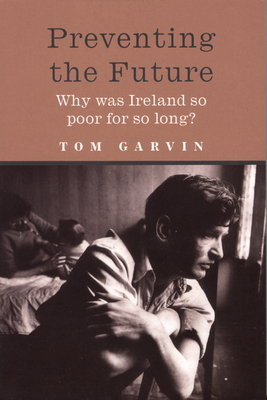Preventing the Future
Anthony Coughlan reviews Preventing the Future: why was Ireland so poor for so long? by Tom Garvin, Gill and Macmillan, ISBN 0 7171 3970 0, £9.99, €12.99 pbk

THE IMPORTANT question that UCD Professor of Politics Tom Garvin seeks to answer in this book is why did Ireland have such low rates of economic growth in the late 1940s and 1950s, in contrast to the continental countries that had been devastated in World War II?
The culprits that he blames for delaying modern Ireland's industrial take-off until the 1960s are: the anti-economic mind-set of the state's key political and social elites, rooted as they were in the social conditions of the inter-war years; and the Irish Catholic Church for fostering such a mind-set, in particular through its hold on the educational system, which was oriented towards the professions rather than science and practical learning and which for decades denied schooling to most young people beyond the age of 14.
In compiling his indictment he gives invaluable insights into 1940s and 1950s Ireland and has much interesting material illustrating the growth of resentment at the social restrictions of the time amongst the more critical elements of Ireland's middle class. The unemployment and emigration crisis of the mid-1950s gave the latter the opportunity to seize hold of the ship of state and open the country to foreign capital and the EU.
That brings us to what Professor Garvin implies is our present enlightened state,"the future" of the book's title, from which we can look back in horror at those reactionary times.
This book is a brilliant attempt to construct a myth of origin of present-day official Ireland, with its individualism, crass commercialism, uncritical Europhilia and media and middle-class anti-clericalism. It savours much of what E P Thompson termed "the immense condescension of posterity".
The Catholic Church gets ' 'doing' at the author's hands, but he is forced to exaggerate the Church's conservative role in holding back economic advance because he ignores or plays down the influence of more significant factors, so that this reviewer for one is unconvinced of the validity of the book's central thesis.
Professor Garvin virtually ignores partition, which was the most important constraining factor on the Irish state from its foundation. James Connolly rightly said that partition would unloose a carnival of reaction and hold back every advanced movement as long as it endured. It was partition more than anything that unleashed roaring reverend bigotry in both parts of the island. Although this has disappeared from the Republic, it survives in the North.
His nod towards partition is only to dismiss its relevance: "A thirty-two county independent Ireland might still have the living standards of 1945, or at least have taken far longer to wake up from the complacencies of the 1940s and break out of the constraints of conservative and obscurantist groups; after all, Northern Ireland had such groups also. One can quite easily imagine an all-Ireland commonwealth where Catholic and Protestant obscurantists conspired together to prevent social, cultural and economic change." One can indeed imagine it, but still think it rather improbable.
The book's other omission is any consideration of the effect on Ireland's economic fortunes of having an implicitly over-valued exchange rate during most of the state's existence because of the profoundly conservative policy of maintaining parity with sterling. The link with sterling was made legally mandatory by the Cumann na nGael government of the 1920s and had nothing to do with Catholic Church influence.
The book contrasts the economic dereliction of the dark 1950s with the economic boom of the bright 1990s, but has little to say on what happened in between, when Ireland's new elite were fully in control of the helm.
In the 1980s, a quarter century after the 'Whitaker Revolution', the Republic of Ireland had a 16 per cent unemployment rate and suffered the emigration of the equivalent of one-fifth of its labour force, 250,000 people. This was a decade when mass expansion of second and third-level education was well under way and Catholic influence on public policy had significantly waned.
The 1980s were no great credit to the Irish political elite. The 'Celtic Tiger' did not get going in 1987, as Professor Garvin implies, but in 1993 when the Irish economic growth rate doubled following the devaluation of that year. Following devaluation the growth rate averaged over 7 per cent annually up to 2001, the only period in the history of the Irish state in which it pursued an independent exchange rate policy and let the currency effectively float and look after itself. This gave Ireland the highly competitive exchange rate that underpinned the 'Celtic Tiger' boom.
Yet official policy had resisted the devaluation, which is why its profoundly positive consequences are largely ignored by establishment commentators up to the present.
In this reviewer's judgement Professor Garvin misses the real targets that explain why Ireland was poor for so long, while writing an important and interesting book on the 1940s and 1950s that is well worth purchasing and reading.
...................................................................................................
Gill and Macmillan reissue Garvin's entire works in paperback
In the wake of the publication of Preventing the Future, Gill and Macmillan have reissued Tom Garvin's back catalogue at £9.99/ 12.99 per edition:
Nationalists Revolutionaries in Ireland 18658-1928 (ISBN 0 7171 3968 9)
1922: the birth of Irish democracy (ISBN 07171 3969 7)
The Evolution of Irish Nationalist Politics (ISBN 0 7171 3967 0)
Connolly Association, c/o RMT, Unity House, 39 Chalton Street, London, NW1 1JD
Copyright © 2005 Anthony Coughlan

